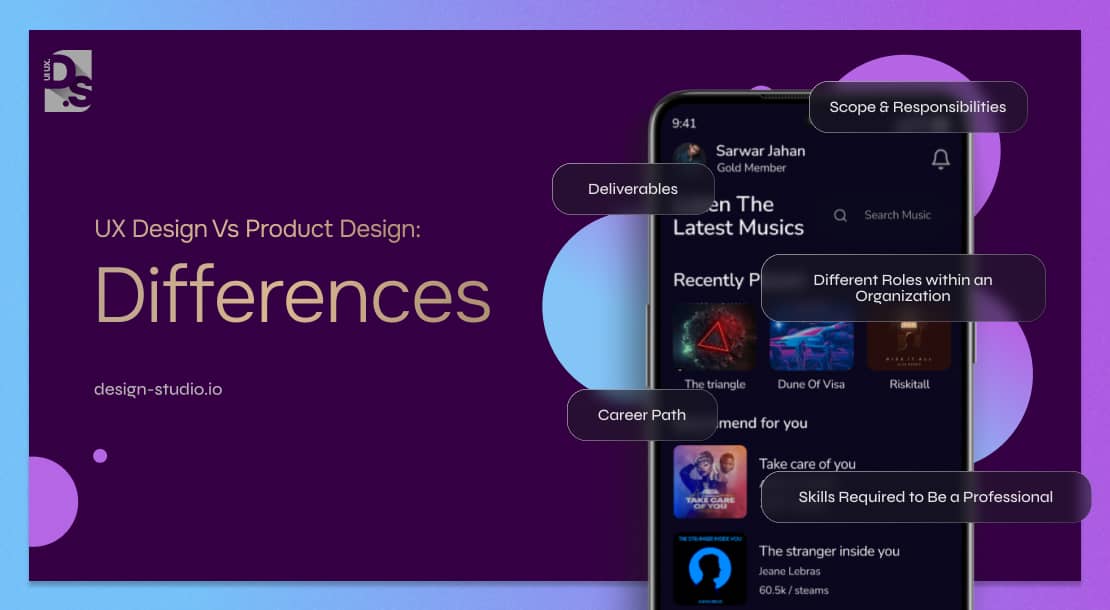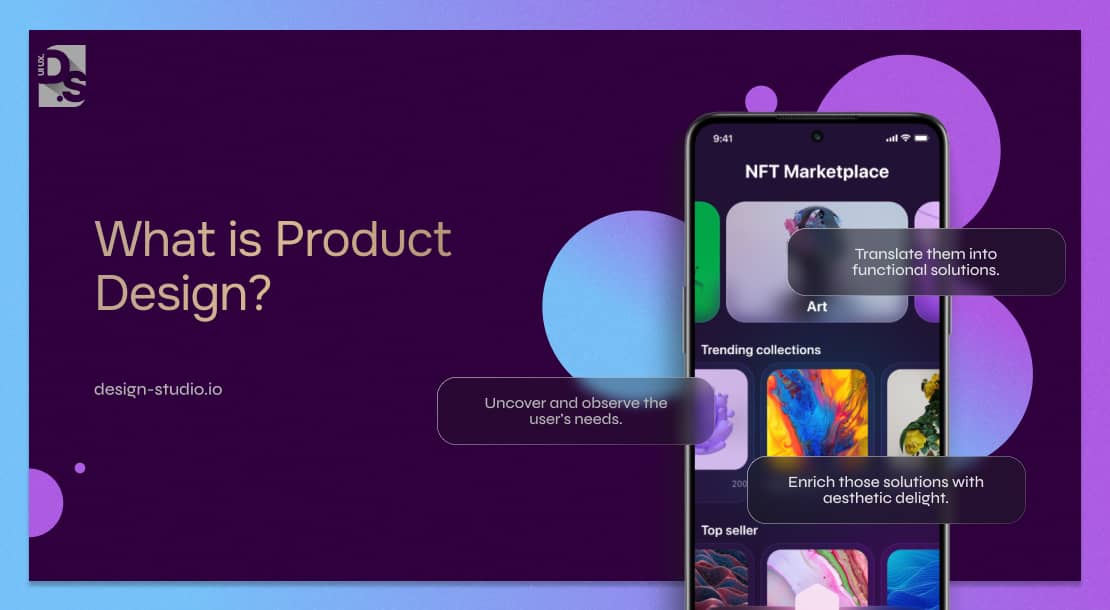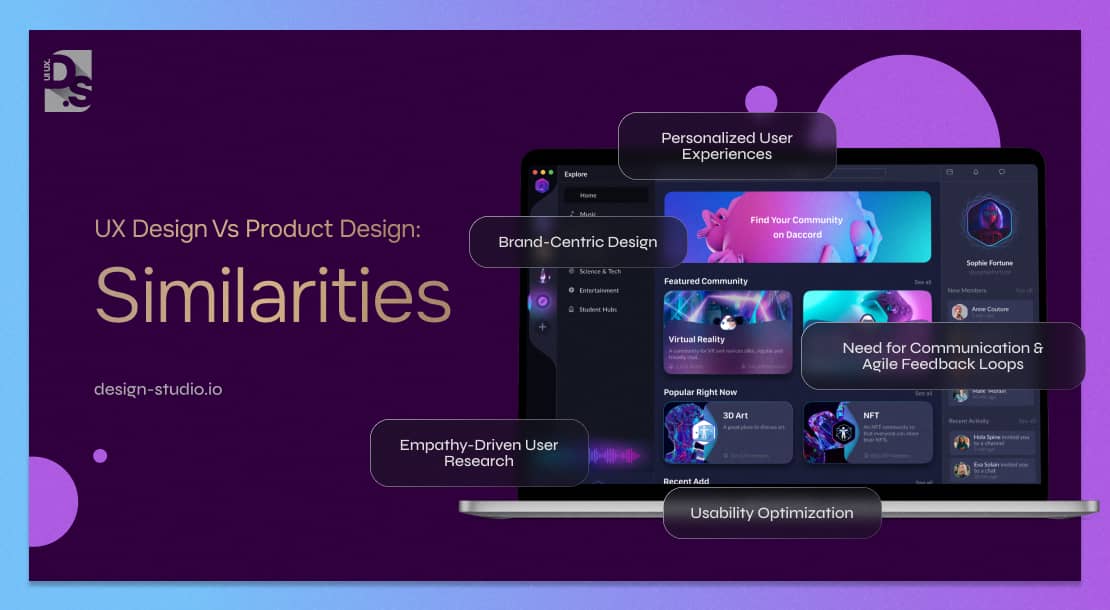UX Designer Vs Product Designer: Differences Revealed
“Product designer” and “UX designer” are two popular design titles. By ‘design titles’ we mean the various roles within design agencies and departments:
- Design titles help companies define roles and responsibilities for team members internally
- They provide employees with a clear way to grow and a sense of career development within their respective fields
- Externally, design titles enable companies to hire candidates with appropriate skills that match the specific needs of the organization
There are no strict rules for how many and what titles companies must have. There is also a huge amount of overlap between both of those titles.
Ask any professional product or ‘User Experience’ (UX) designer. They’ll tell you they check out both types of job postings – whether it says “principal product designer” or “lead UX designer.”
Here are some of the most popular full-time design positions or titles we found in recent job posts. We’ve also included how many years of experience companies require for each title:
- Junior product designer (normally this is seen as a first full-time design job)
- UX Researcher (2+ years)
- UI Designer (3+ years)
- Product designer (4+ years)
- UX Designer (4+ years)
- UI/UX Designer (4+ years)
- Senior product designer (5+ years)
- Principal product designer (10+ years)
- Director of product design (9-12 years)
- VP of product design (12+ years)
Here’s one thing to keep in mind about these titles: companies call the product design role different things:
- Junior product design roles are called “UX designer” at Amazon
- Most junior to mid-level product design roles are called “interaction designers” at Google
- Most product design roles are called “experience designers” at Airbnb
All three do similar work. So, why are these terms used so interchangeably?
UX Designer vs Product Designer: Understanding the Confusion

When the Internet first took off, ‘UX design’ or ‘product design’, was called information architecture. Over time, new roles and titles came along. The role of information architecture (IA) gradually reduced to “figuring out the navigation” for apps and websites.
What was ‘IA’ yesterday is ‘UX design’ or ‘product design’ today. The field of designing digital products that people can freely use has had many ‘titles’ in the past two decades:
- Man-Machine Interface (MMI) Design
- Ergonomics
- Human-Computer Interaction (HCI)
- User-Centered Design (UCD)
- Usability Engineering
- User Experience (UX) Design
- Customer Experience (CX) Design
- Product Design
- Interaction Design
- Experience Design
Legendary designer Jakob Nielsen calls this phenomenon ‘UX vocabulary inflation.’ According to him, the terminology used to describe roles and concepts in the field is too unstable and expansive. It is the source of all the confusion in the “Product designer” vs “UX designer” debate.
Product Designer vs UX Designer: Core Difference
- A product designer has about 6 to 7 roles (at least) in the whole product design process
- A UX designer has 3 to 4 roles
- A UI designer or UX researcher has one
So, the core difference between these job titles is their scope. The product designer has the broadest scope. UX designers only have to worry about how users will react to a product’s design. Product designers will have to balance user needs with business viability
Let us break down the titles “Product designer” and “UX designer” to understand all the different roles.
What is a Product Designer?

A product designer is a professional who oversees the entire design process of a product, from conception to launch and beyond:
- They define product goals
- Create project roadmaps
- Ensure that the product design project meets user needs and aligns with business objectives
- Collaborate with marketers to develop compelling product narratives
- Conduct user research to gather insights about user needs
- Develop user personas to inform design decisions
- Create wireframes, prototypes, and UI style guides to visualize the product
- Collaborate with developers to ensure the technical feasibility of the project
- Collect user feedback during testing and post-launch
- Maintain product desirability by overseeing iterative design improvements
That is too much work for one professional, right? Not quite. Yes, product designers are expected to handle various tasks. But, they are not expected to take on every task hands-on.
They usually oversee the work of specialized team members which include UX researchers, UI designers, project managers, and UX designers:
- Product designers oversee UX design processes to ensure a user-centered approach
- They make important UI design decisions to maintain visual consistency across the product
- They coordinate with project managers to align timelines and deliverables
The scope of a product designer’s role will vary significantly based on the size and resources of the organization:
- In larger companies, product designers typically work within a dedicated team
- They focus on one product at a time
- They collaborate closely with UX designers, UI designers, and other specialists in the organization
- They have strategic oversight over all things related to the product
In smaller companies or startups, product designers may have to do more than just oversee things:
- They may have to serve as the main UX researcher and user testing expert simultaneously
- These personnel may have to work on Figma or Sketch to create interface prototypes hands-on
- They may even be responsible for coding and post-launch product maintenance
Overall, product designers play the main role in championing products from ideation to launch. How much work they actually do during this process depends on the context. Either way, the scope of their work far exceeds that of UX designers.
Main Tasks of Product Designers
- Defining product goals based on user needs and business requirements
- Creating project roadmaps, timelines, milestones, and deliverables
- Overseeing the user research process
- Sharing research-based insights from the UX research department with the rest of the team
- Overseeing the UX design process
- Overseeing the UI design process
- Supervising the creation and testing of wireframes and prototypes
- Collaborating with marketing teams to develop branding and marketing strategies
- Working with developers to ensure the technical feasibility of designs and facilitate the smooth implementation of all product features
- Engaging with sales professionals to support sales efforts
- Gather insights during testing and post-launch phases to identify areas for improvement
- Oversee iterative design improvements based on user feedback and changing market conditions
Management-Related Tasks of Product Designers
- Communicate and present design concepts to stakeholders
- Use Agile Methodologies to manage product design cycles
- Leading workshops and design sprints
- Being aware of the internal business context, i.e., organizational structure, department incentives, revenue streams, customer acquisition, the roadmap, etc.
- Being aware of the external business context i.e., the market, competition, and industry
- Knowing how to translate all of the above into design
Main Skills of Product Designers
- Problem-solving
- Project management
- User Centered Design
- Using insights from research to identify business opportunities
- Defining and managing product roadmaps
- Creating and executing product strategies
- Resource management
- Ability to identify revenue or user streams for the product
- Proficiency in visual design principles
- Ability to create prototypes and wireframes
- Capability to interpret user data to inform design decisions
Secondary Skills of Product Designers
- Familiarity with HTML, CSS, and JavaScript to communicate effectively with developers
- Understanding of market trends
- Ability to align user, business, and design goals
- Excellent interpersonal skills to work effectively within cross-functional teams
- Public speaking (for product presentations)
- Business acumen
- Data Science
- UX research skills
Tech Expertise of Product Designers
- Proficiency in popular app and web design software tools like Figma, Sketch, or Adobe XD
- Experience with tools like InVision and Axure for developing interactive prototypes
- Familiarity with platforms like UserTesting and Lookback for performing user research and usability tests
- Understanding of tools like Google Analytics to collect and analyze user data
Ultimately, if a product fails to provide a healthy ROI, the clients will hold the product designer accountable.
What is a UX Designer?

A UX designer is a professional dedicated to enhancing the user experience of a product. Their primary goal is to understand how users interact with a product and strive to improve that interaction throughout the design process.
Main Tasks of UX Designers
- Conducting user research
- Helping the UX research team perform interviews, surveys, and usability testing
- Creating user personas with the researchers to identify the most important user needs
- Researching industry trends and analyzing competing UX design strategies
- Setting UX goals
- Mapping all possible user journeys and interactions within the product
- Designing wireframes and prototypes
- Overseeing UI design work, ensuring all visual elements align with UX goals
- Conducting usability tests on prototypes
- Iterating on designs based on user data and testing results
Management-Related Tasks of UX Designers
- Routinely communicating design ideas and findings to all stakeholders, especially the product designer
- Working with product designers and managers to align project goals, timelines, and deliverables
- Leading design thinking workshops and sprints
Similar to product designers, the scope of a UX designer’s role will vary depending on the size/structure of the organization:
- In larger companies, they work alongside product designers, UX researchers, graphic designers, UI designers, and other specialists
- In smaller agencies or startups, UX designers will take on a more hands-on approach
- They may have to use tools like Adobe Photoshop or Adobe Illustrator to create and manipulate visual assets for interfaces
- They may have to perform user research, wireframing, prototyping, and even some aspects of UI design – all on their own
UX designers play an all-important role in advocating for the user. They are the bridge between the product’s design and its user base. That is why they need to have a wide variety of skills:
Main Skills of UX Designers
- Expertise in conducting different types of research methods (surveys, card sorting, usability testing)
- Creating wireframes and prototypes using tools like Figma, Sketch, or Adobe XD
- Information Architecture (ability to create navigation structures and organize content)
- Usability testing
- Strong verbal and written communication skills for conveying design ideas, collaborating with team members, and presenting to stakeholders
Secondary Skills of UX Designers
- Creative problem-solving
- Capacity to interpret research data and user feedback
- Strong teamwork skills to work effectively with cross-functional teams
Tech Expertise of UX Designers
- Proficiency in design tools such as Figma, Sketch, or InVision for wireframing and prototyping
- Familiarity with platforms like UserTesting and Lookback for usability testing
- Strong understanding of analytics platforms like Google Analytics to analyze user behavior
- Familiarity with tools like Principle, After Effects, or Framer to create animation effects
- Familiarity with HTML, CSS, and JavaScript to communicate effectively with developers
- Experience in using UI component libraries like Bootstrap or Foundation
- Experience in using visual assets from component libraries like Material Design or Ant Design
Ultimately, if a product ranks low on usability, UX designers will be held accountable.
Product Designer vs UX Designer: Similarities

Usually, UX designers move up the career ladder to become product designers. Here’s how that ladder usually goes:
- Pursue a bachelor’s degree in design, psychology, or a related field
- Gain practical experience through internships
- Take courses or certifications in UX design
- Start your career as a Junior UX designer
- After learning design tools, assisting senior designers, and taking part in multiple projects, become a “UX designer”
- After collaborating with multiple cross-functional teams, become a senior UX designer
- Lead major design projects, mentor junior designers, and continuously build your portfolio
Now, to undergo a transition from UX designer to product designer:
- Gain additional skills in product and design thinking, problem-solving, and other industry-specific technical knowledge
- Pursue opportunities that allow you to expand your design scope beyond UX
- Pursue roles that cover the entire product lifecycle
- Complete tasks that include big-picture planning and strategizing
- Apply for a product designer role
By building upon your UX design skills, you can eventually transition into a product designer role
That is why there are so many similarities between the two fields:
Personalized User Experiences
- Both roles aim to create tailored experiences for users
- Product designers ensure that the product is market fit and ready to resonate with users
- UX designers further customize the product’s design to meet the preferences of their target users
Brand-Centric Design
- Product and UX designers consider the brand’s identity in their work
- They both make design choices that reflect and promote the brand’s values
Empathy-Driven User Research
- Both product designers and UX designers prioritize understanding user needs, expectations, and pain points
- They either conduct or oversee all types of user research
Iterative Design Process
- Both product and UX designers embrace an iterative approach
- They continuously refine their designs based on user feedback and testing results
Collaboration with Cross-Functional Teams
- Both roles require collaboration with various stakeholders
- Effective communication and teamwork are essential in both roles
Adoption of Design Thinking Methodologies
- Both fields utilize design thinking principles to guide their processes
- They emphasize empathy, ideation, and prototyping
Use of Similar Design Tools
Commitment to Continuous Learning
- Both roles require a commitment to staying updated with industry trends, technological advancements, best practices
- Designers in both fields actively seek out new knowledge and skills to enhance their design capabilities
Product Designer vs UX Designer: Differences
Now, let us go through all the remaining differences between the two design titles:
Objective
- A product designer’s primary goal is to conceptualize and design a product that is both user-friendly and profitable
- A UX designer’s primary goal is to make the product more user-friendly
Perspective
- Product designers approach the product from a business perspective
- UX designers approach the product from the user’s perspective
Qualifications
- To secure a position as a product designer, candidates need to have been part of product design teams before
- They need to have a background in some form of specialization be it UX design or visual design
- UX designers also need a bachelor’s degree and a strong portfolio
- But, they do not need to have past experience in product design teams
- In many cases, junior UX designers will join product design teams with no prior experience
Career Paths
- Product designers typically have backgrounds in design, engineering, or related fields
- UX designers often come from design, psychology, or related backgrounds
- UX designers only have to focus on refining user experiences from the start of their careers
- Product designers have to oversee different parts of the product lifecycle across their careers
Here’s how their career paths differ:
| Product Designer Career Path | UX Designer Career Path |
| Associate Product Designer Entry-level role focusing on a specialization (research, visual design, etc.) and supporting senior designers | Junior UX Designer Entry-level role assisting in user research, wireframing, or other specialization |
| Mid-Level Product Designer Manages projects and collaborates with cross-functional teams | UX Designer Takes a leadership role and ownership of design projects |
| Senior Product Designer Leads major projects and mentors junior designers | Senior UX Designer Leads research initiatives and mentors junior designers |
| Lead Product Designer Oversees multiple product lines and coordinates with stakeholders | UX Director Sets the vision for user experience and leads large teams |
| Director of Product Design Manages the design team and sets strategic direction | Mid-Level Product Designer Manages projects and collaborates with cross-functional teams |
Deliverables
Product designers are involved in the product creation process long before the design begins. The types of ‘deliverables’ they have to provide include:
- Product roadmaps outlining the product’s strategic goals and the overall development timeline
- Comprehensive documents that align product design plans with long-term brand objectives
- Technical documents detailing features, functionalities, and requirements of the product
- Design systems
- Market research reports
- Stakeholder presentations to communicate product vision to team members
UX designers enter the framework once the product vision has been loosely described. The deliverables they usually share include:
- Wireframes
- User personas
- Customer journey maps
- Usability test reports
- Interactive prototypes
- Information Architecture
- Style guides that outline the product’s typography, color schemes, and other visual elements
You can see how vastly different the two jobs are just from these lists.
Salary
- The average salary for a product designer in the US is $119,090
- The average salary for a UX designer in the US is $129,338
- Both roles offer lucrative salaries, especially to experienced professionals
- But, product designers usually get paid better because they have to wear more hats
Conclusion
There you have it – an in-depth breakdown of the UX designer vs product designer debate! Which career path interests you more? Reach out to Design Studio to let us know which role you prefer.

comments
Add comment